Australia leads the way in the global climate crisis, facing its serious effects with growing severity. Knowing what climate change means for Australia is crucial, as the country deals with rising temperatures, severe weather, and major threats to its unique ecosystems and lifestyle.
Energy Matters encourages you to explore this vital information, empower yourself with knowledge, and take action now to secure Australia’s future by switching to cleaner energy solutions.
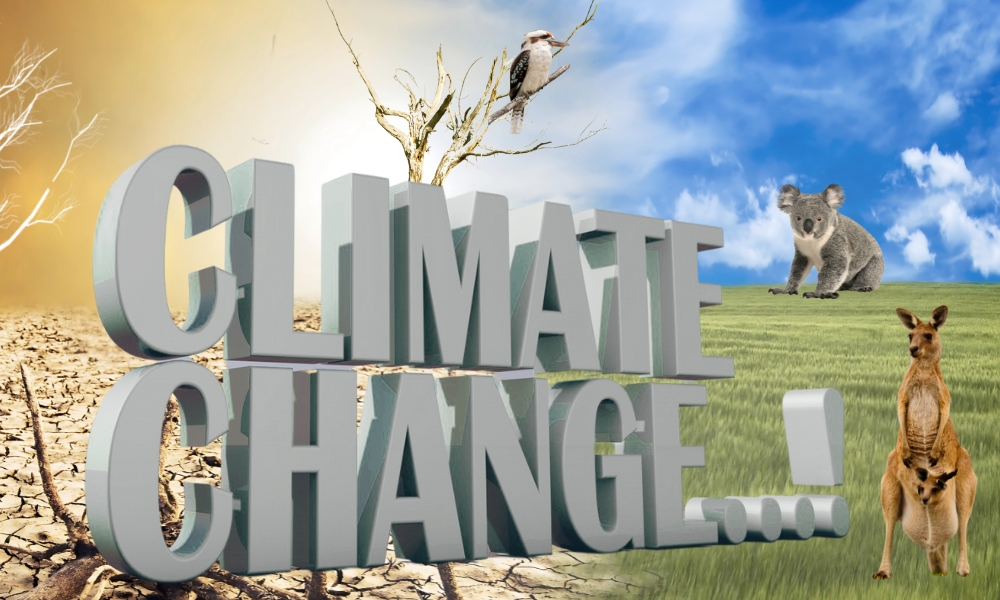
On this page
Did you know Energy Matters is Australia’s largest renewable news, blog and educational resource? Subscribe to Energy Matters’ weekly newsletter and keep updated even with incentives, rebates and recommended solar product offers.
What is climate change in Australia?
Climate change describes long-term changes in temperatures and weather patterns. Although these changes can occur naturally, human activities have been the main cause since the 1800s, mainly through burning fossil fuels like coal, oil, and gas, which release heat-trapping gases.
In Australia, this leads to more frequent and severe extreme weather events, creating significant challenges for the environment, economy, and public health. Since 1910, Australia has warmed by about 1.51°C on average.
Climate change basics: What’s happening right now
Temperature rise
- Australia’s average temperature has risen by about 1.51 °C since 1910, with most warming since the 1950s.
- The year 2024 was the second‑hottest year on record, with an anomaly of +1.46 °C above average, second only to 2019 at +1.51 °C.
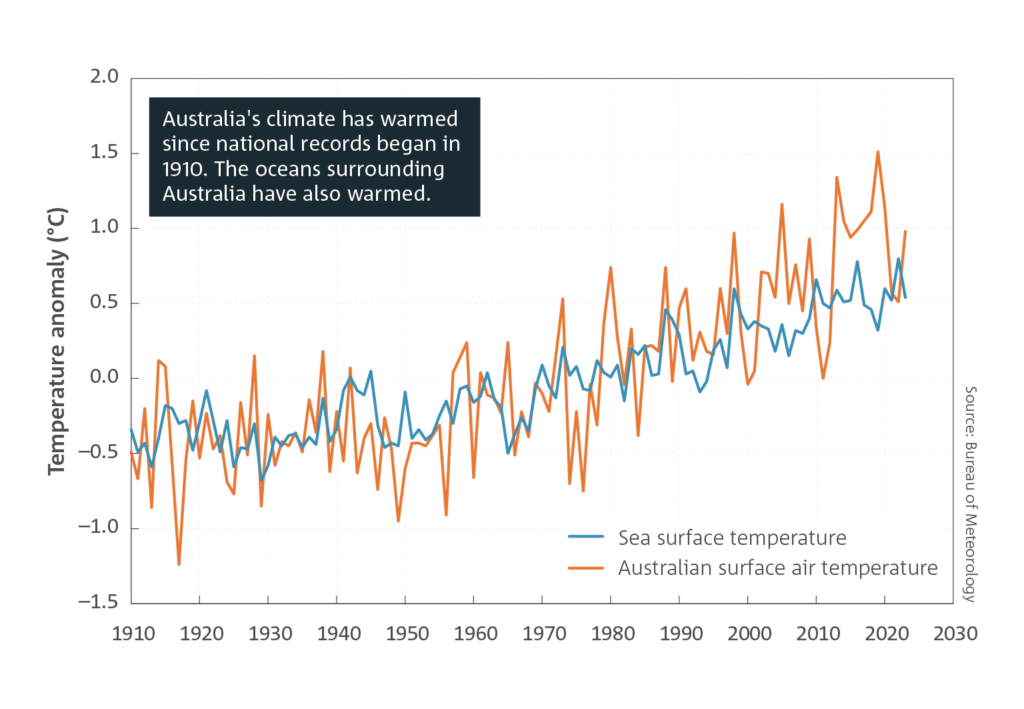
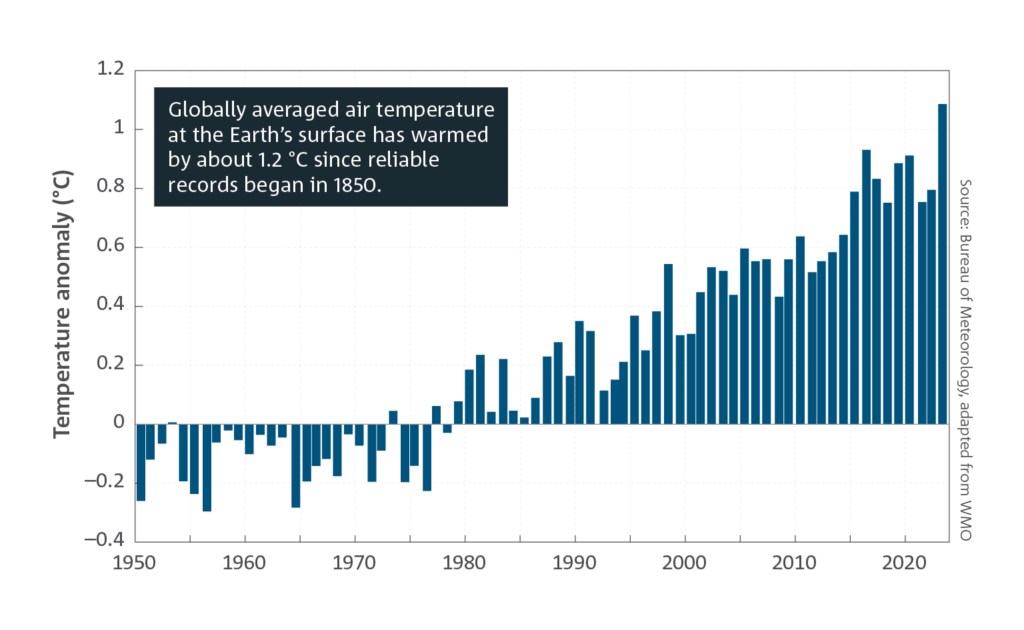
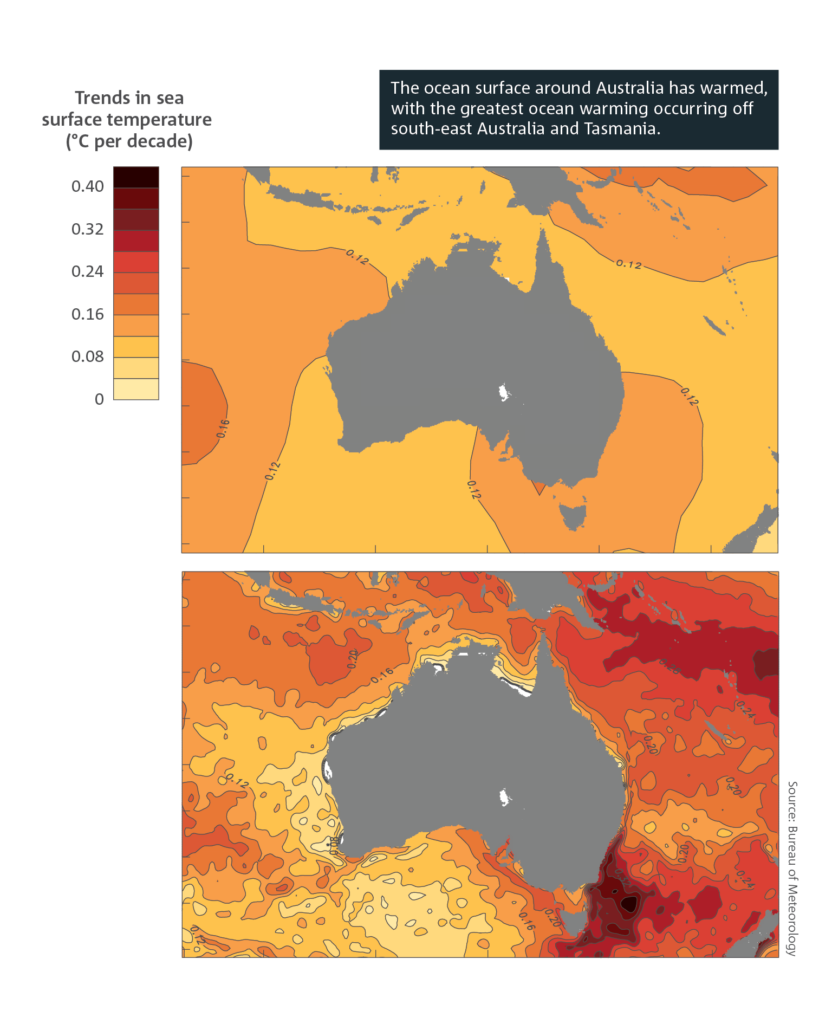
Rainfall trends
- Rainfall in southwestern and southeastern Australia has declined by 10–20% since the 1970s.
- Northern Australia has seen increasing precipitation, though western and southern regions have become drier.
Extreme weather events
- Heatwaves are more frequent and intense, with hot records outpacing cold by a factor of three in the past decade.
- Dangerous fire‑weather days have increased since the 1950s, particularly in southern Australia.
- Heavy rainfall intensity has increased by 10% or more since 1979.
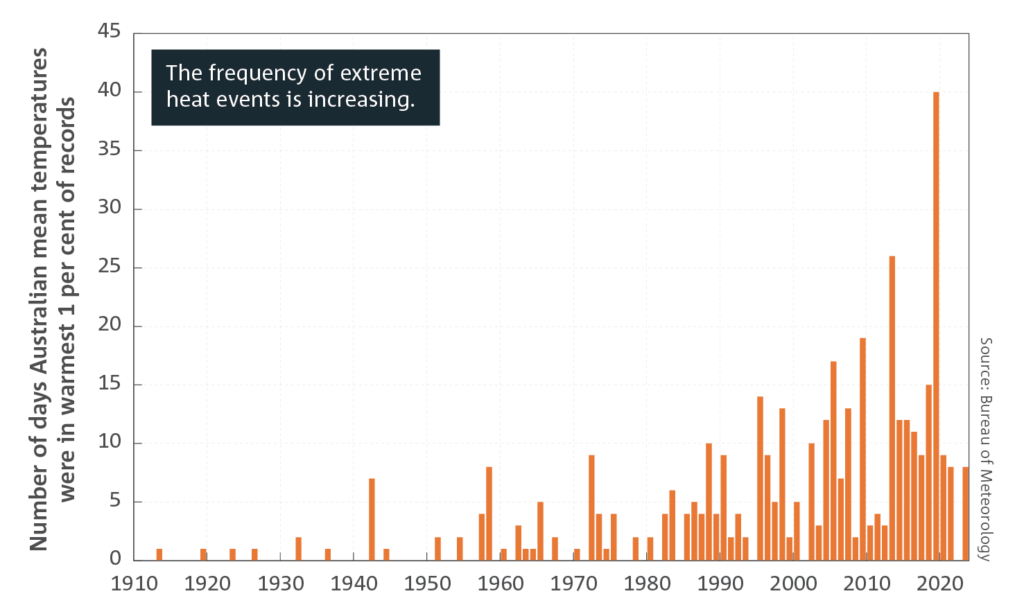
Sea level rise
Sea levels around Australia are rising faster than the global average, with 0.2–0.3 m likely by 2050 and potential inundation costs to infrastructure.
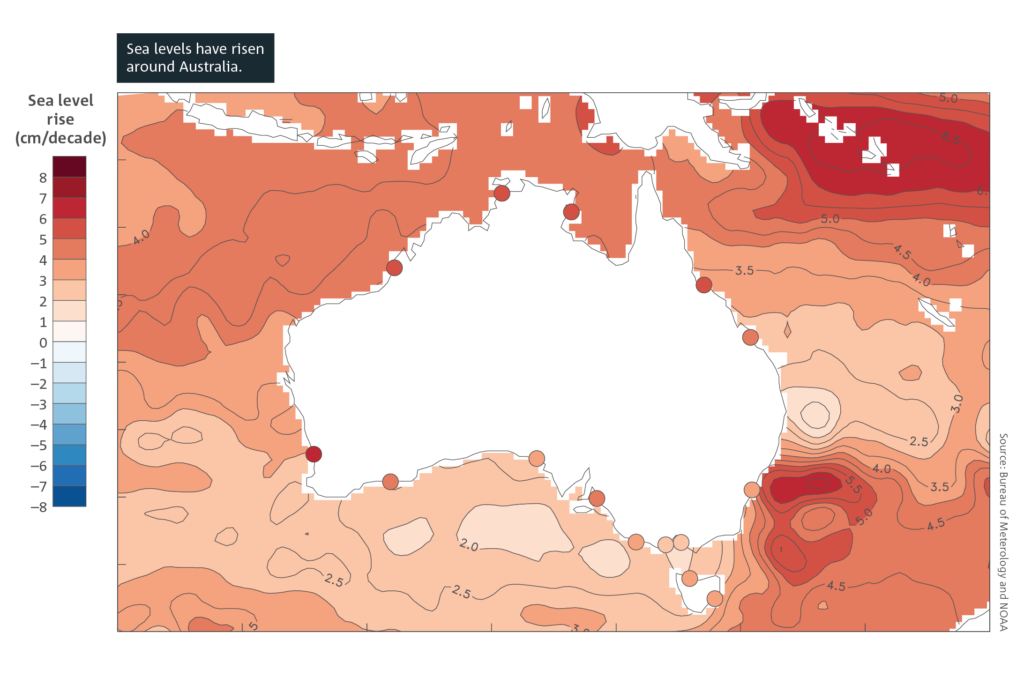
Global warming causes in Australia
Greenhouse gas emissions
The global warming causes at work in Australia largely stem from human‑released greenhouse gases.
- Australia emitted million tonnes of CO₂‑equivalent in the year to March 2021, lower than the previous year, and lower than 2005 baseline levels.
- Per capita, emissions are among the world’s highest CO₂, about three times the global average.
- Fossil fuels—especially coal—account for the largest share of emissions, with coal power generating grid electricity in 2020.
Enhanced greenhouse effect
- The enhanced greenhouse effect occurs when emissions of CO₂, methane and nitrous oxide trap extra heat in the atmosphere, disrupting climate systems.
- Since 1750, CO₂ levels have increased, intensifying warming trends.
Other contributing factors
- Changes in land cover (like deforestation) reduce carbon sinks and modify surface albedo.
- Natural factors like solar variation and volcanic eruptions have a minor influence compared with human activity, confirmed by models comparing natural vs actual warming trends.
Impacts of climate change in Australia
Bushfires and heatwaves
- Smoke inhalation caused over 400 premature deaths during that season in NSW alone.
- The 2019–20 Black Summer bushfires burned over 19 million ha, killed 33 people, devastated ecosystems, and killed or displaced nearly 3 billion animals.
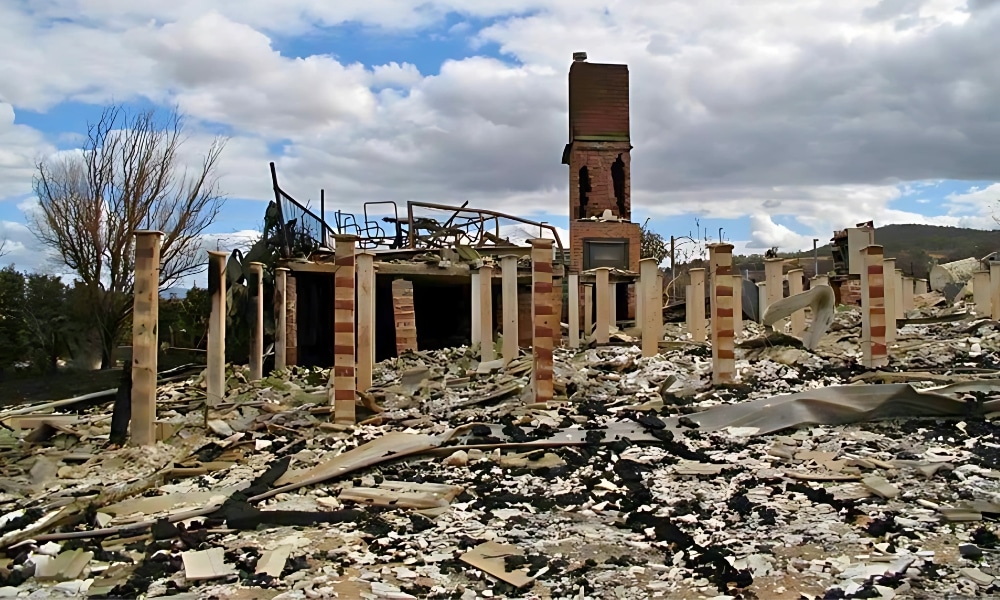
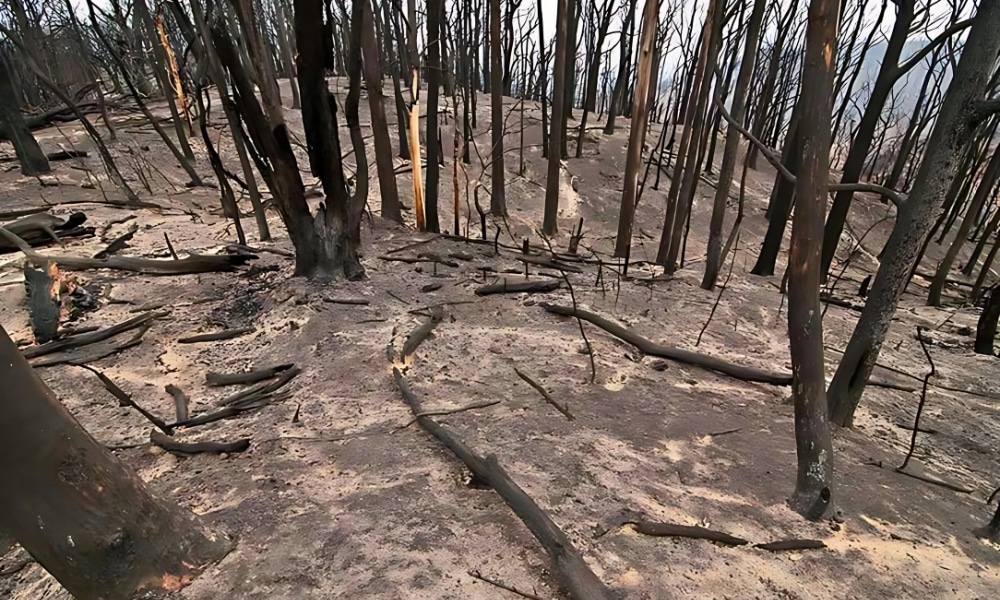
Health, infrastructure, and communities
- CSIRO projections for a 1–2 °C rise include the spread of malaria receptivity zones, a surge of dengue exposure, diarrhoeal diseases among Aboriginal children, and more people exposed to floods.
- Indigenous and remote communities are disproportionately impacted by heat, poor housing, and limited access to air conditioning.
Agriculture, economy, and good security
- Despite declining rainfall, Western Australian wheat yields have doubled since 2015 through innovations like no‑till farming, deep‑soil ripping, new seed varieties, and soil conditioning techniques.
- Without adaptation, mega‑droughts, lost crop revenues, and infrastructure damage could cost Australia significantly.
Ecosystems and biodiversity
- Intensified bushfires threaten koalas; in NSW, koala habitat burned, risking local extinction by 2050 without intervention.
- The Great Barrier Reef, many native species, and unique ecosystems are under threat from warming, acidification, and habitat loss.
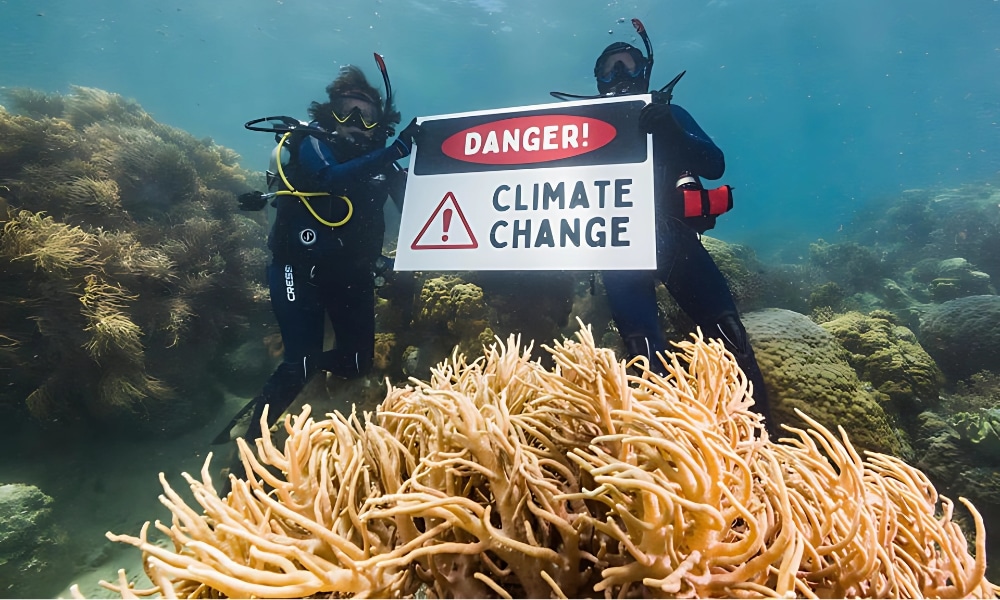
Climate change basics of adaptation and mitigation
Mitigation strategies
- Transitioning energy systems from coal to renewable sources like wind and solar, supported by battery and storage capacity, is key to reducing emissions. Australia is quickly boosting renewables capacity but still lags behind policy targets.
- Improving energy use efficiency, electrifying transport and industry, and restoring natural carbon sinks are key mitigation steps.
Adaptation initiatives
- Coastal planning, flood defence upgrades, ecosystem resilience measures, and community heat‑stress supports are critical adaptation strategies.
- In farming, Australian innovators have used techniques like crop rotation, soil amendment, and drought‑tolerant wheat to improve yields despite rainfall decline.
Sources: DCCEEW – Understanding climate change | NSW Government – Australian climate change observations | CSIRO – Greenhouse gases, State of Climate | Bureau of Meteorology (Australian Government) – State of the Climate 2024 | Reuters – Less rain, more wheat: How Australian farmers defied climate doom | CSIRO – Climate projections for Australia

Summary table – climate change basics at a glance
Topic | Key facts |
Climate change definition | Long‑term change in weather patterns, with human influence dominant in Australia. |
Global warming causes | Emissions of CO₂, methane, and nitrous oxide from fossil fuels, agriculture, and transport. |
Temperature rise | +1.5 °C since 1910; 2024 second‑hottest year; further warming projected |
Rainfall trends | Decline in southern regions; increases in the north; seasonal shifts. |
Extreme events | More heatwaves, bushfires, intense rainfall, hailstorms, and sea‑level inundation. |
Emissions stats | Gross emissions down ~2% since 2005; coal still dominant. |
National targets | 43% cut by 2030; net zero by 2050; annual reporting mandated. |
Adaptation & mitigation | Shift to renewables, improved farming techniques, community health measures, and coastal defence. |
Why understanding climate change basics matters
- Knowing the climate change definition and global warming causes helps Australians make sense of weather shifts and extreme events.
- Awareness of projections highlights urgency: temperature rises by 2070 could radically alter ecosystems, agriculture, infrastructure, and public health.
- Recognising government targets and performance gaps empowers citizens to advocate for stronger policy, faster renewable deployment, and equitable adaptation.
These educational videos serve as a great visual aid for understanding climate change.
What Energy Matters encourages you to do
- Educate yourself: learn what climate change means for your region, economy, and health.
- Adapt and act: improve energy efficiency at home, support local climate adaptation planning, and make sustainable choices.
- Advocate for equity: ensure vulnerable communities—predominantly Indigenous and remote groups—are protected.
- Support clean energy: back policies and investments that phase out coal and expand solar, wind, and battery storage.
Use Energy Matters’ easy-to-use solar power and battery storage calculator to determine the size of your solar system with storage! Our solar calculator will generate performance information and potential savings.
We can send this information to 3 of our pre-vetted and trusted local installers in your area to receive obligation-free solar quotes and take the first step towards true energy independence!
Move forward with a clean energy transition alongside Energy Matters
Understanding climate change basics, including climate change definition and global warming causes, is vital for Australians confronting rising temperatures, bushfires, sea‑level rise and other threats. Awareness of current data and future projections empowers individual and community action.
Energy Matters calls on you to get informed, support clean energy transitions, and stand for climate justice. Together, we can help secure Australia’s resilient, low‑carbon future.
Our team of solar experts can help you obtain up to 3 FREE solar quotes from pre-qualified and vetted solar firms in your area. Act now with Energy Matters for a stable, safer climate tomorrow.
















































